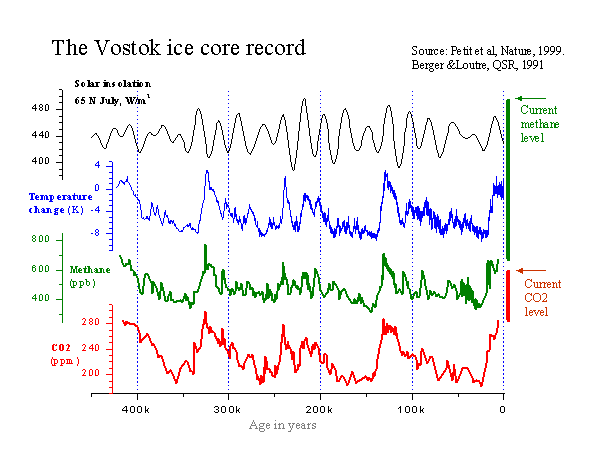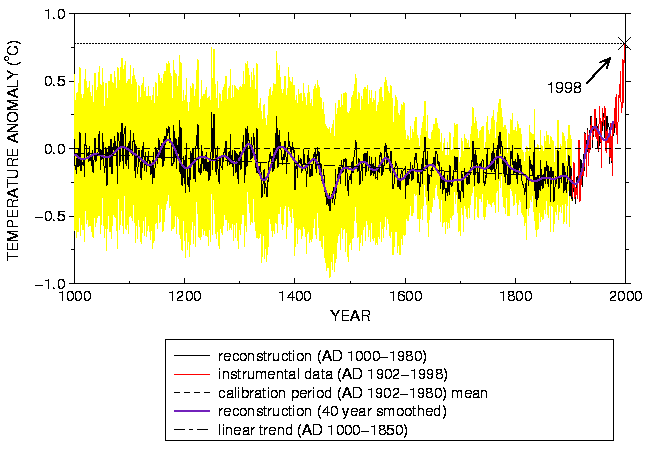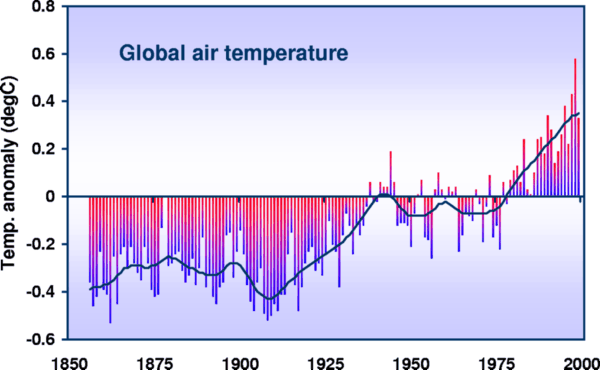Climate variability and climate change — the last
120 million years
CSIRO Atmospheric Research Greenhouse Information Paper
In the long-term past, the planet has been both warmer
and cooler than today. Climate fluctuations arise because of changes to
the Earth’s orbit, to solar radiation, to the positions of continents,
and to concentrations of atmospheric greenhouse gases.
More recently, the 20th century was the warmest of the past 1000 years.
The 1990s were the warmest decade of the millennium in the northern hemisphere,
and 1998 was the warmest year.
Greenhouse gas increases were the main factor contributing to global
warming in the late 20th century.
This information paper examines how global climate has changed throughout
history and describes the factors likely to be causing the changes experienced
during the past 100 years.
Climate throughout history
The past 120 million years
The Cretaceous Period (120-65 million years ago) was 5-7oC warmer than
present and carbon dioxide concentrations were much higher than today.
Cooling then occurred during the Tertiary Period to the Quaternary Period
(2.5 million years ago). During this time, climate was influenced by the
location and configuration of continents, the presence or absence of ice
sheets, changes to the Earth’s orbit that affected radiation received
from the Sun, and high greenhouse gas concentrations.
Geological evidence shows the Earth’s climate is very sensitive
to changes in concentrations of greenhouse gases. Models cannot accurately
simulate climate of the past 120 million years without incorporating the
heat trapping capacity of these gases.
The past one million years
Most of the past one million years was characterised by a series of changes
from ice ages (glacial periods) to interglacial periods about every 100,000
years and other variations with periods of about 40,000 and 20,000 years.
These coincide with variations in the Earth’s orbit — the so-called
"Milankovitch" cycles — that affect the amount and the
distribution of solar radiation reaching the Earth.
However, changes to solar radiation alone cannot explain the size, rate
and distribution of past temperature changes revealed by evidence from
ice cores, sea and lake sediments and continental records.
During the past four transitions from glacial to interglacial periods
(Figure 1), changes to the Earth’s orbit initiated warming, which
was amplified first by increased greenhouse gas levels and then by reduced
reflectance as northern hemisphere ice sheets melted several thousand
years later. Concentrations of carbon dioxide and methane increased almost
in phase with the glacial-interglacial warmings. Carbon dioxide concentrations
lagged the coolings during glacial onset. However, the exact phasing of
temperature and carbon dioxide changes is not the main issue. The important
finding is that greenhouse gas variations caused up to half of the amplitude
of the temperature changes over the glacial-interglacial periods.
Surges of ice and melt water from large ice sheets also had significant
and abrupt effects on climate during or immediately following glacial
periods, mainly by altering ocean circulation patterns.

Figure 1: Changes to solar radiation levels, surface temperature, methane
and carbon dioxide concentrations deduced from ice cores extracted from
Vostok in Antarctica. There have been four ice ages and intervening warmer
periods during the past 400,000 years. (Source: Nature)
The past 1000 years

Figure 2. Temperatures of the northern hemisphere for the past 1000 years.
(Mann, M.E., R.S. Bradley and M.K. Hughes (1999) Northern hemisphere temperatures
during the past millennium: inferences, uncertainties and limitations.
Geophysical Research Letters, 26, 759-762.)
Evidence of climate variability is more abundant for the past millennium
and the factors that affected climate are better understood. Figure 2
presents northern hemisphere temperatures based on a range of measurements.
Twentieth century warming runs counter to a slight millennial-scale cooling
trend expected from changes to the Earth’s orbit.
The past 150 years
Figure 3 shows direct observations of global temperatures since the 1850s.

Figure 3. Globally-averaged surface temperatures from the instrumental
record. (Source: Climatic Research Unit and the UK Met. Office Hadley
Centre)
The main factors influencing climate since the mid-19th century include
aerosol — tiny particles suspended in the air — from volcanoes
and human sources, as well as from solar fluctuations, stratospheric ozone
depletion and greenhouse gas increases. El Niño – Southern
Oscillation events also affect climate. However, the changes in surface
temperature since the mid-19th century can only be accurately simulated
by models that include greenhouse gases and aerosols resulting from human
activity.
Greenhouse gas increases are considered to be the main factor contributing
to the warming observed in the late 20th century. Of the greenhouse gases
increasing in concentration due to human activity, carbon dioxide is likely
to have caused the most warming, followed by methane, tropospheric (lower
atmosphere) ozone, halocarbons and nitrous oxide.
Aerosol arising from burning fossil fuels have a cooling effect that
partly offsets warming due to carbon dioxide.
November 2000
|